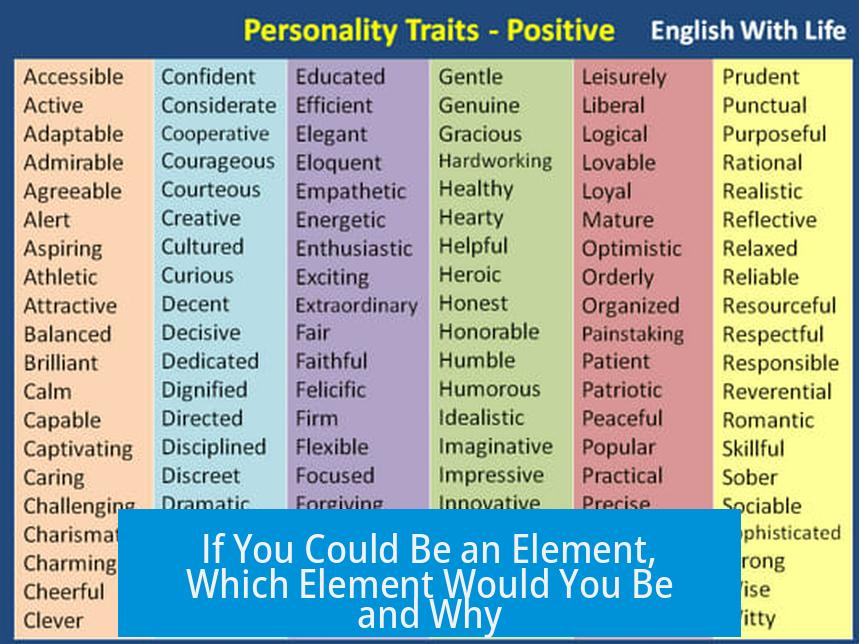If You Could Be an Element, Which Element Would You Be and Why?

The choice of an element to embody reveals personal views, chemical knowledge, and metaphorical imagination. People select elements based on traits like stability, reactivity, uniqueness, or social analogy. Deciding between noble gases, reactive metals, or rare elements involves different interpretations of their properties and significance.
Chemical Identity and Personal Metaphor
Many choose elements for their distinct chemical personalities, which serve as metaphors for individual traits.
- Fluorine is prized for its extreme electronegativity and possessiveness of electrons: “Fluorine, the electrons are all mine and no one can say otherwise.”
- Sodium represents loneliness and volatility: “I’d be sodium, lonely but reacts terribly with most others.”
- Carbon is viewed as “The element of life” and “a versatile little creature” highlighting its central role in organic chemistry and life itself.
- Oxygen (O2) embodies essential reactivity and sustenance: “I’d be O2, you can’t live without me babe.”
This metaphorical identity reflects emotional or social characteristics translated through chemical behavior.
Noble Gases as Symbols of Peace and Fun
Several participants opt for noble gases due to their chemical inertness, symbolizing calmness or uniqueness.
- Helium is chosen for nobility and tranquility: “Helium, I want to be the most noble element” and “Helium so I could get some peace and quiet.”
- Neon represents brightness sparked under excitation: “Neon. Small and inert, but if you excite me, I’ll brighten your life.”
- Argon symbolizes chill and non-interference: “Argon, I’m just trying to chill, not trying to get into it with anyone or anything.”
- Krypton is chosen for quiet presence: “I’ll just be krypton cuz it have my 2 first letters of my name and because I don’t to disturb anyone and noone could disturb me.”
These choices highlight a preference for peaceful coexistence and individuality without confrontation.
Exotic, Rare, or Radioactive Elements
Some prefer elements notable for their rarity, instability, or scientific fascination.
- Rhenium is valued for obscurity: “When was the last time anyone thought about rhenium?”
- Plutonium combines exotic chemistry and power: “Plutonium Exotic chemistry and phases, incredibly useful in niche applications and greatly feared/respected,” “Plutonium 239 cus boom.”
- Francium emphasizes short life span: “Francium, I wouldn’t live that long” and a paradox of fleeting presence followed by nobility in ‘the afterlife.’
- Ununoctium (Oganesson) symbolizes synthetic rarity and instability: “Highly exotic, mostly synthetic, incredibly unstable, and my relationships only exist for a very short time in the lab.”
These selections interest those fascinated by scientific uniqueness and fleeting existence.
Reactive and Dangerous Elements
Some embrace elements known for reactivity or hazards, reflecting boldness or risk-taking traits.
- Bromine is portrayed as dangerous yet “badass”: anecdotal experience describes a serious spill causing acute poisoning, making Bromine both fascinating and formidable.
- Uranium is described with destructive power: “If I got into a fight or in an awkward conversation then I can just clap my hands and the problem as well as anything in a 20km radius will be gone.”
- Mercury reflects uniqueness and unpredictability: “Has one of the most ‘I’m not like others’ feel to it.”
- Palladium balances usefulness and lethality: “Very useful in small doses, lethal in larger doses.”
Color and Aesthetic Appeal
Some choose elements because of their visual or perceptible qualities.
- Iodine thanks to its violet color and complex chemistry: “Because of its beautiful violet color and can form heptavalent compounds.”
- Silver is valued for shiny appearance and usefulness: “Shines up nicely when needed but gets tarnished with neglect.”
Social and Relational Analogies
Elements become metaphors for social behavior or connection styles.
- Nitrogen: “I want to be only with the people who understand me good, and I react explosively with those that do not.”
- Molybdenum: Chosen “so I’d have friends,” reflecting its presence in biological enzymes.
- Hydrogen: “I’m number 1” but “I can’t seem to keep friends,” reflecting hydrogen’s singular proton and tendency to not stay isolated.
Summary Table: Common Element Choices and Their Symbolism
| Element | Reason or Trait | Representative Quote |
|---|---|---|
| Fluorine | Extreme electronegativity, possessive | “Electrons are all mine” |
| Helium | Noble, peaceful, fun | “Want to be the most noble element” |
| Carbon | Versatility, life element | “The element of life” |
| Plutonium | Exotic, powerful, feared | “Plutonium 239 cus boom” |
| Bromine | Dangerous, badass | “Acute bromine poisoning experience” |
| Neon | Inert, bright under excitation | “If you excite me, I’ll brighten your life” |
| Uranium | Destructive power | “Problem gone in 20km radius” |
Conclusion: Why This Question Matters
Choosing an element to personify integrates chemical knowledge with personal expression. The decision exposes views on stability, reactivity, uniqueness, and social dynamics. It challenges the chooser to reflect on traits they admire or identify with in nature’s fundamental substances.
- Elements represent both chemistry and metaphorical identity.
- Noble gases capture peace and individuality.
- Reactive, rare, or hazardous elements appeal to those who value power, risk, or scientific curiosity.
- Color and aesthetics influence some choices.
- Social analogies link chemical behavior to human interaction.
What element symbolizes a mix of being both reactive and unique?
Fluorine fits this well. It’s highly reactive and fiercely holds onto its electrons. Another choice is oxygen, known for being reactive and crucial for life.
Which elements represent loneliness or solitude, and why?
Sodium is often seen that way, being quite reactive but usually isolated. Argon and krypton are inert noble gases, staying peaceful and unbothered.
Why do some choose helium as their element?
Helium is noble and inert, symbolizing peace. Others choose it because of its playful qualities, like making voices high or being “fun at parties.”
Which elements are chosen for their exotic or rare nature?
Ununoctium (Oganesson) and plutonium are popular for this. They are unstable, rare, and have unique, sometimes powerful, roles in science and nature.
How do social traits connect to element choices?
Neon brightens up social situations, representing personality. Nitrogen reacts only with those who truly understand it, symbolizing selective interaction.





Leave a Comment